A personal witness to the devastating demise of wild pollinators and other species as glyphosate herbicides increase in the environment Rosemary Mason MB ChB FRCA
In March 2006, UK’s Natural Environment Research Council (NERC) announced the closure of its wildlife research centres [1], a decision opposed by 99% of 1 327 stakeholders. Monks Wood centre, which hosted BBC’s Spring Watch, pioneered work on DDT and pesticides in the 1960s, and more recently revealed how climate change is affecting wildlife, with spring arriving three weeks earlier. The research centres were also involved in assessing the impacts of GM (genetically modified) crops on wildlife, with findings contradicting industry claims that no harm would be caused.
In response to that and to the unexplained disappearance of birds and invertebrates (such as bumblebees, honeybees and other pollinators), we set aside one acre of the field next to our house in South Wales to make a chemical-free nature reserve.
To begin with we had considerable success. We photographed many insects that were clearly benefitting from wild flowers, often insignificant ones, which supplied nectar and pollen resources but which had been eliminated from many conventional arable fields. The reserve also provided larval food plants for several species of moths, butterflies and bush crickets.
In 2009, I had major surgery followed by radiotherapy. The work on the reserve diverted me from dark thoughts, and insomnia allowed me to make nocturnal visits around the reserve and adjacent fields to see speckled bush crickets in their most active periods. With a bat detector set at 40 kHz, a torch and recording device, I followed the ‘singing’ adult bush crickets and recorded the progress of their courtships. In fact ‘stridulation’ is a sound produced by the males rubbing a tooth-bearing left wing across a scraper on the right wing. Courtship and mating takes place at the highest point. It was amazing how many I heard and saw. The same frequency picked up the staccato discharge of pipistrelle bats performing their erratic aerobatics as they hunted insects along the hedge above my head. I would hear tawny owls calling to each other, such a haunting sound, and follow the voice with my ears, as the owl moved on silent wings between groups of trees.
After observations made during the summer of 2009, we published a photo-journal: Speckled Bush Crickets. Observations in a small nature reserve [2] (see Box 1). On 10 February 2010, Dr David Robinson, who is studying the behaviour and acoustics of Leptophyes punctatissima (Speckled Bush Crickets) at the Open University, said: “I think that it is probably the first time anybody has produced a book about a single species.” He gave a copy to Dr Judith Marshall, who is the British expert on grasshoppers and crickets at the Natural History Museum.
At the end of 2010, we published another photo-journal, The Year of the Bumblebee. Observations in a small nature reserve [3] (see Box 1). The United Nations had declared 2010 the International Year of Biodiversity, to celebrate the diversity of life on earth. It also marked the year by which 200 countries had promised to halt biodiversity loss. In 2010 we set ourselves the task of identifying the six common types of bumblebees, their emergence, behaviour and the species of flower from which they took pollen and nectar.
Box 1
Extracts from photo-journals [2, 3] & other observations
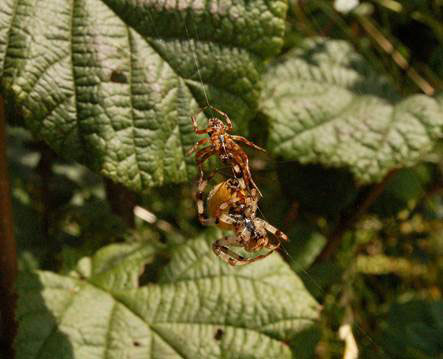
Mating strategy in the female spider Araneus quadratus
“At fence post 22 on 16thAugust 2010, I was lucky enough to witness and photograph the courtship and mating of Araneus quadratus, an orb web spider, in our 1-metre high hedge.” Spiders reconstruct their webs during the night. “An early morning photograph illuminated by a torch, showing the previous night’s work. The prey catching web of an orb web spider is amazingly intricate. It was much more complex than her courtship web, which looked as if it had been thrown together in a hurry! There are strong frame threads and radial threads, after which the spider lays down a temporary auxiliary spiral which she takes down as she constructs the sticky prey- catching spiral. This ends before the central hub, leaving a free zone.”
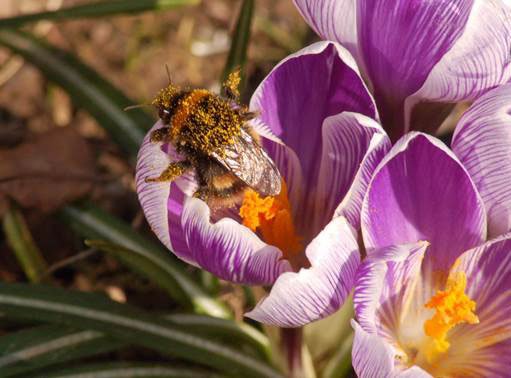
The first pollen of the year for the Bombus Terrestris March 5th 2010
“She descended like a helicopter, feet first into a large, purple crocus flower and disappeared completely. Apart from a faint tremor of the petals you would have been unaware she was there if you hadn’t actually seen her go in. Some 5-10 s later she emerged head first over the threshold, liberally powdered with pollen and crawled out like a drunk, narcotised by the first decent meal of the year.”
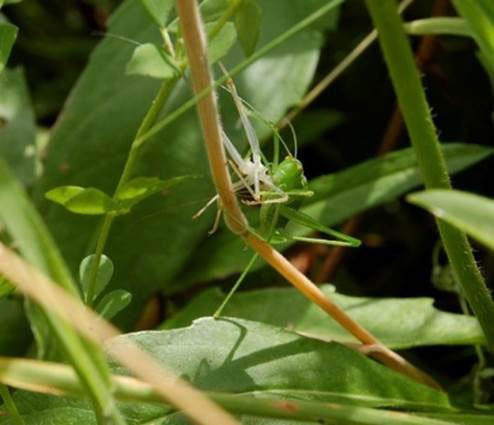
Moulting in a Speckled Bush Cricket nymph, August 8th 2009
“She sat with her right hind leg extended and braced against the leaf below with the left leg flexed and acting as a counterbalance. The forelegs grasped the shroud and the two mid legs were used as stabilisers. The external mouthparts, mandibles and palps were clearly visible and this time I could see the mouthparts moving. She had chosen a perfect day on which to perform her ecdysis. She and her other self were poised like ballet dancers caught in the spotlight of the sun, casting surreal shadows on the scabious leaf below. At the end of 16 minutes all that remained was a pair of tibia, still hooked by their tarsi to a trefoil leaf above. Presumably she must have mentally calculated that the nutritional gain from climbing up and unhooking them was hardly worth the effort.”
The Ladybird Ball
For two weeks in April 2010 we studied 7-spot ladybirds. They are remarkable predators and natural pest removers! They steadily graze their way through aphids and mildew spores. We made counts three times a day; morning, afternoon and evening. During those periods they migrated from positions in the field during the day and usually gathered on shrubs in the western hedge in the early evening sunshine; field maple, hawthorn, blackthorn, hornbeam and hazel. Here they fed, rested and mated. Although they meet by accident, the factors that govern their behaviour (they are attracted by light and move against the force of gravity) meant that they climb upwards and are drawn to the same places. In those 2 weeks we counted 348 ladybirds.
Three plant species that supported the insects
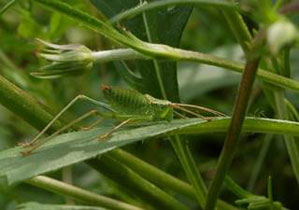 |
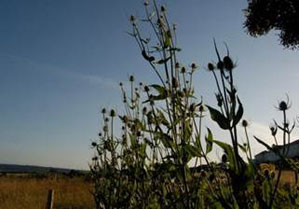 |
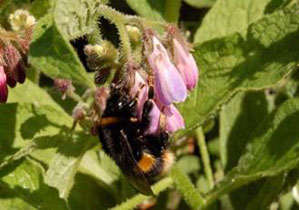 |
| August 5th 2009: Male speckled bush cricket nymph on devil’s bit scabious leaf; ‘proof of grazing’. | July 7th 2010: ‘The Teasels grew and grew, like Jack’s beanstalk, and had to be staked up against the July gales!’ Teasels were the favourite flower of the new bumblebee queens. They were used for both feeding and roosting. | August 18th 2010: Bombus terrestris, buff-tailed bumblebee, has a short tongue which cannot reach the inside of the bell-shaped flowers of the Comfrey. She solves the problem of a short tongue by ‘stealing’ it. The short tongue penetrates the base of the flower. |
By 2013 we knew that something was wrong. The numbers and species of invertebrates in our reserve were declining. Their behaviour was abnormal. In August, some of their food plants were uniformly affected with mildew.
In 2006, we had commissioned an overnight moth count [4] from a professional naturalist. The next morning at about 6 am when he emptied the traps, he recorded (while we photographed) 143 species of moths, attracted to the bright lights from a wide radius. Some species trapped were in numbers up to 500. We were astounded by the variety of species and asked if it was to do with the sunflowers which we had grown in the field as a winter crop for birds. No, he replied, it was because we weren’t using pesticides and we had allowed the small wildflowers to flourish.
In 2013 we asked him to repeat the count. He confirmed our worse fears, the biodiversity had declined. He counted only 51 species and the maximum number of the same species was 50. By August 2014, a naturalist friend with a reserve 3 miles away had stopped doing moth counts. He said there were so few that it wasn’t worth the effort.
In April 2013, we were sent a scientific paper by Anthony Samsel and Stephanie Seneff, which showed that glyphosate’s suppression of Cytochrome P450 enzymes and amino acid biosynthesis by beneficial gut microbes has led to a variety of human diseases that globally reach epidemic proportions in populations on a Western diet, including gastrointestinal disorders, obesity, depression, autism, infertility, cancer and Alzheimer’s disease [5].
We had no idea that glyphosate and other pesticide residues had been contaminating our staple foods since before 2002, according to UK Defra (Department for Environment, Food & Rural Affairs) Expert Committee on Pesticide Residues in Food (PRiF) [6] and neither had our friends in Wales and in Denmark. Following the recommendations by Monsanto, farmers had been using glyphosate as herbicide throughout the crop growth cycle; and at the end they were also desiccating (drying) or ripening crops with glyphosate sprayed about 7-10 days before harvest [7]. So, some of us in Europe are receiving glyphosate residues in all our non-organic staple foods, such as bread, cereals, potatoes, pasta, pulses, rice, sugar, beer, whisky, etc.[6] and many foods from the US made from corn or soya (mostly GM).
Not only that, a collusion between UK’s PRiF, European Food Safety Authority (EFSA) and Germany as Rapporteur Nation for European Union with Monsanto led to a 100-fold increase in the permitted glyphosate levels in lentils “In order to accommodate the authorized desiccation use of glyphosate on lentils in the United States and Canada” without consultation with European Parliament or the public (see Box 2).
Box 2
Collusion between the UK Expert Committee on Pesticide Residues in Food (PriF), the European Food Safety Authority (EFSA) and the German Rapporteur Member State with Monsanto to raise glyphosate levels in lentils 100-fold without consulting European Parliament or the public
In the PriF Report of Quarter 4 of 2011 on lentils [8, p. 27] 16 samples were above the Maximum Residue Limit (MRL) of 0.1 mg/kg. [The highest level was 0.9 mg/kg]. Its risk assessment concluded that none of the residues detected would be expected to have an effect on health. The main reason: “A new, higher MRL for glyphosate on lentils is expected to come into force in summer 2012. None of the residues detected in this survey would be above this new proposed MRL.”
EFSA published the following paragraph on its website [9] soon afterwards:
“According to Article 6 of the Regulation (EC) No 396/2005, Germany, herewith referred to as the Rapporteur Member State (RMS), received an application from the company Monsanto Europe to set an import tolerance for glyphosate in lentils. In order to accommodate the authorized desiccation use of glyphosate on lentils in the United States and Canada, the RMS proposes to raise the existing MRL for lentils [0.1 mg/kg] to 10 mg/kg. The RMS Germany drafted an evaluation report according to Article 8 of Regulation (EC) No 396/2005 which was submitted to the European Commission and forwarded to EFSA on 1 August 2011.” This was granted by EFSA in January 2012.
There was no public consultation; the request from Monsanto was granted as a matter of routine.
When humans ingest glyphosate residues in staple foods, or animals get them in GM feed, beneficial bacteria are continually being destroyed causing failure of absorption of nutrients and minerals. Worse yet, the toxic bacteria on the other hand can thrive.
We learned later from colleagues in the US that Monsanto has a total of four patents filed on the chemical. They bought it as a chelator of heavy metals (used for cleaning boilers by ‘grabbing’ minerals) [10] and then marketed it as herbicide [11]. In addition they filed a patent on it as an antibiotic in 2002 [12] and as an antiprotozoal against malaria in 2003 [13]. Samsel & Seneff subsequently published another paper on the chemical: Glyphosate, pathways to modern diseases II: celiac sprue and gluten intolerance [14].
According to Monsanto, the glyphosate herbicide formulations Roundup® Pro Biactive and Roundup® Pro Biactive 450are [15] “approved for weed control in amenity, industrial and forestry and aquatic areas. It can be used at any time of the year as long as weeds are green and actively growing. Monsanto advises re-spraying if die-back is not observed at 6 weeks [16].
New rules from the regulator Chemicals Regulation Directorate (CRD) in 2012 prohibits blanket spraying of any herbicide on non-porous hard surfaces. But “targeted treatment” is recommended on roads and pavements in the spring, and higher rates in autumn, and even a late autumn application [15].
With such comprehensive recommendations from Monsanto, it would not be surprising if glyphosate has saturated the environment, not only in agricultural areas but within cities in all residential areas. People and wildlife are exposed to unprecedented and still largely unknown levels of what is now known to be a highly toxic herbicide (see [19] Why Glyphosate Should Be Banned, and chapter 1 in [20] Ban GMOs Now, both ISIS special reports).
In August 2013, when the Roundup® spraying season was into its 5th month, we commissioned BioCheck to measure glyphosate in tap water and river water. This is a company attached to the Veterinary School in Leipzig where the Department, headed by Prof Dr Monika Krüger, had been doing glyphosate levels in the urine of pigs, dairy cows, chickens and farmers (they all had increased levels in their urine, in particular cattle with chronic botulism) [21, 22].
The level of glyphosate in one Welsh river draining from areas of Japanese knotweed spraying was 190 parts per trillion (ppt) and in local tap water was 30 ppt. These were of the order of concentrations found in a study in 2013 which showed that breast cancer cell proliferation is accelerated by glyphosate in extremely low concentrations [23]: “The present study used pure glyphosate substance at log intervals from 10-12 to 10-6 M. These concentrations are in a crucial range which correlated to the potential biological levels at part per trillion (ppt) to part per billion (ppb) which have been reported in epidemiological studies.” In the UK the incidence of breast cancer has almost doubled between 1975 and 2010 [24].
No-one can tell us (not the contractor, Complete Weed Control Ltd [25] nor the City and County Council) how much Roundup® has been used in the Swansea area over the last 10 years.
Chemicals Regulation Directorate (CRD) admits to the widespread use of Amenity Pesticides but fails to monitor them. CRD had commissioned Risk & Policy Analysts in association with Britt Vegetation Management to undertake studies on the usage of amenity pesticides. In 2010, none of the questionnaires were returned by the Contractors or Councils in Wales or Ireland [26]. The most alarming aspect was the extent of Amenity use of Herbicides. The surface types treated by Amenity Plant Protection Product (PPP) users in 2008 were specified on p. 11 of the document [26] as amenity grass, sports turf, woodland, tree/shrub beds, riparian areas/areas beside water, open water/aquatic areas, gravel ballast surfaces, pavement kerbs, road and other hard surfaces, construction sites with ‘a weed issue’ and broken surfaces covered with rubble.
In 2006, for example, at least 8 species of the family of shield bugs (Order: Hemiptera), 5mm to 15mm, were identified. Some are named after a specific shrub; e.g. hawthorn, birch, juniper, sloe or gorse, but all can be seen on other deciduous trees or types of vegetation.
In April 2014, a few shield bug young were seen. After April we saw a small number of adult shield bugs but no ladybirds. On 22 August in the early morning, I walked down the path between the fence posts and the hedge; there was not a single spider’s web.
In March 2014, a red-tailed queen that had over-wintered from 2013 was seen searching for nest sites, but no new queens appeared in July 2014. The leaves of several of their food plants had mildew, the spores of which are secondary food of the 7-spot ladybirds. These natural ‘pesticides’ had vanished. Species which we had grown as food plants for moths and butterflies were uneaten.
|
|
|
|
August 29th 2014: left, devil’s bit scabious, leaves with mildew, in flower, but few insects; middle, teasel: leaves with mildew, no insects taking pollen; right, comfrey, leaves with mildew, no insects taking nectar/pollen.
Analysis in local tap water in August 2014 revealed a 10-fold increase since August 2013; from 30 ppt to 300 ppt. If Roundup® continues to be sprayed in the same quantities (whatever they are), this area of South Wales will become a biological desert. At the same time, Glyphosate-resistant Japanese knotweed has appeared in August 2014, regrown after spraying early in 2014. We have photographed these in fields and along the roadside (not shown).
We discovered that in 1996, the Attorney General of the State of New York, Consumer Frauds and Protection Bureau, Environmental Protection Bureau successfully brought a case against Monsanto with regard to: False advertising by Monsanto regarding the safety of Roundup® herbicide (glyphosate) [27].
Despite having been convicted of false claims in 1996, Monsanto repeated the same lies in a document published 2010 entitled “The agronomic benefits of glyphosate in Europe” [28, p.3]: “Since its discovery in the early 1970’s the unique herbicidal active ingredient glyphosate has become the world’s most widely used herbicide because it is efficacious, economical and environmentally benign. These properties have enabled a plethora of uses which continue to expand to this day providing excellent weed control both in agricultural and non-crop uses to benefit mankind and the environment.” Further, it states that glyphosate has an “excellent safety profile to operators, the public and the environment.” (italics added)
On page 4 [28] Monsanto makes another fraudulent claim about the use of glyphosate in increasing wildlife and biodiversity: “Increased wildlife and biodiversity: Use of glyphosate instead of mechanical weed control techniques on non-cropped/amenity land preserves wildlife like small mammals and birds. Adoption of Conservation agriculture encourages earthworms and other invertebrates as well as birds. Judicious use of glyphosate to control excessive plant growth and invasive weeds on or around waterways and lakes encourages wildfowl and much other wildlife.”
An additional claim was made for GM Crops (p. 4): “Use of glyphosate tolerant crops allows later control of weeds providing early food sources for many invertebrates and birds and thus increases animal numbers.”
Craig Childs, author of Apocalyptic Planet, describes searching for signs of life in 2012 on a farm in Grundy Count, Iowa, which was growing Monsanto’s GM Bt Roundup® Ready corn [29]: “I had come to a different type of planetary evolution. I listened and heard nothing, no bird, no click of an insect.”
American journalist Robert Krulwich reviewed Apocalyptic Planet [30]:
“Yet, 100 years ago, these same fields, these prairies, were home to 300 species of plants, 60 mammals, 300 birds, hundreds and hundreds of insects. This soil was the richest, the loamiest in the state. And now, in these patches, there is almost literally nothing but one kind of living thing. We’ve erased everything else. There’s something strange about a farm that intentionally creates a biological desert to produce food for one species: us. It’s efficient, yes. But it’s so efficient that the ants are missing, the bees are missing, and even the birds stay away. Something’s not right here. Our cornfields are too quiet.”
We wrote to many people (the Council, the Welsh Assembly, the Chemicals Regulation Directorate and the HSE among others) to tell them about glyphosate in our drinking water. We begged them all to stop its use, but the replies were virtually identical; “The German Rapporteur Member State and EFSA are doing a reassessment for 2015.”
On 9 July 2014, ISIS circulated Scandal of Glyphosate Re-assessment in Europe (SiS 63) [31], revealing that the German Rapporteur Member State’s Federal Institute of Risk Assessment (BfR) and its federal agency partners did not actually review the published toxicology studies, but relied on a summary provided to them by the Glyphosate Task Force (GTF), a consortium consisting of Monsanto and chemical companies all over Europe, including Syngenta UK and Dow Italy, with an odd one from Taiwan. GTF describes itself as [32] “a consortium of companies joining resources and efforts in order to renew the European glyphosate registration with a joint submission.” Hence Monsanto and other companies who stood to gain from selling glyphosate herbicides were given free rein to pronounce glyphosate effectively even safer than before [33], hence the increase in Acceptable Daily Intake (ADI) recommended in the RAR.
GTF systematically excluded all independent peer-reviewed studies that reported congenital birth defects, reproductive problems and cancers in humans and animals; studies reporting the presence of glyphosate in human or animal urine; long term (24-month) feeding studies in rats that showed liver damage, kidney damage, tumours and endocrine disruption, and any study reporting high levels of AMPA, a toxic metabolite of glyphosate, in the environment. It also excluded all studies using Roundup, as only the ‘active ingredient’ pure glyphosate was risk assessed for toxicology, despite the fact that Roundup is the most widely used glyphosate herbicide in Europe, and adjuvants in the formulations are known to be highly toxic and have synergistic effects on glyphosate toxicity (see [19, 20]).
Unsurprisingly, GTF’s evaluation of peer-reviewed literature regarding ecotoxicity [34] also broadly concluded that glyphosate is not harmful to the environment.
We strongly challenge this conclusion; we believe glyphosate is likely responsible for destroying biodiversity in our small nature reserve in South Wales. There is also already evidence of glyphosate/Roundup toxicity to frogs, aquatic ecosystems, soil ecosystems, and link to demise of Monarch butterflies, as well as diseases and birth defects of livestock [20]. The relevant evidence for ecotoxicity was dismissed in the RAR [34] in the same cavalier way as toxicity of glyphosate for humans [31]. The disappearance of wildlife hardly bodes well for human health [5, 14] as already suggested, and as epidemiological evidence shows (see below).
Studies published in 2013 in the Journal of American Medical Association (JAMA) [35] and the Lancet [36] respectively show that between 1990 and 2010, US and Britain have slipped down the scale of health compared with other wealthy nations.
An All-Party Parliamentary Group (APPG) on Agroecology meeting on 18 June 2014 brought together world experts on glyphosate. One of them, senior scientist at US Department of Agriculture and world expert on glyphosate Dr Don Huber showed a slide [37] summarising diseases that have increased in incidence since 1995, correlated with the red line representing the increasing use of glyphosate in the US.
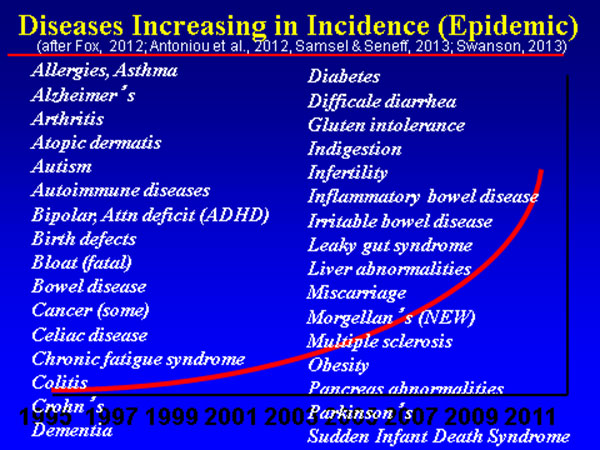
Huber ended a talk he has given all over the world as follows [38]:
“Future historians may well look back upon our time and write, not about how many pounds of pesticide we did or didn’t apply, but by how willing we are to sacrifice our children and future generations for this massive genetic engineering experiment that is based on flawed science and failed promises just to benefit the bottom line of a commercial enterprise.”
About the Author

Rosemary Mason has had a longstanding interest in conservation, and was former Chair of the West Area, Glamorgan Wildlife Trust. She had worked for the National Health Service for 35 years as Consultant Anaesthetist to West Glamorgan Health Authority, authored Anaesthesia Databook: A perioperative and peripartum manual, Edns 1989, 1994 and 2001, Cambridge University Press, served as Assistant Editor of Anaesthesia 1990-2000, and was awarded Pask Certificate for Services to Anaesthesia 2001. Rosemary now lives in South Wales with her husband Palle Uhd Jepsen, former Senior Adviser in Nature Conservation to the Danish Forest and Nature Agency.
Article first published 17/09/14
Comments are now closed for this article
There are 7 comments on this article.
Melvyn Firmager Comment left 18th September 2014 02:02:15
Dear Rosemary,
I know a lot about this, but reading this still brought tears to my eyes.
I congratulate you on this mammoth task, and hope against all hope that, enough people will take notice.
We too on our two acres, having planted 350 trees, have seen a serious decline in insect and bird life. The spring dawn chorus that used to a deafening cacophony of sound - before the trees were planted, is now the sound of individual birds!!
Hopefully you are well now and can lead something of a normal life, as far as the 'Monsantos' will allow. As a healer I empathise
Wth kind regards
Melvyn
Henry Nicholls Comment left 18th September 2014 05:05:34
You speak the truth. Birds and insects are decimated. It is a wicked thing, but companies have no ethics or scruples. They are not human. Human beings merely work for them.
Kind regards,
Henry
Susie Greaves Comment left 18th September 2014 22:10:13
Dear Rosemary,
The work you have completed and your determination to uncover the effects of glyphosate are invaluable. They become part of an archive for others like myself(who are not scientists) to spread the word.
On a personal note, I hope you are recovered. I was very moved to hear of you comforting yourself after radiotherapy with nocturnal walks on your land.
Thank you
Susie Greaves
Cllr Jacqi Hodgson Comment left 1st October 2014 16:04:30
Many thanks for this informative and detailed report. As a local Town and District (Green Party) Councillor I have been working in South Devon with colleagues to try and ensure that Roundup is recognised for the dangerous product that it is and stop it being used for routine kerbside spraying. Your report will be most useful in this vital work. Please put me on any mailing list you use to receive any updates that you consider would be useful.
Susan Littleton Comment left 4th October 2014 03:03:25
You deserve much recognition and an award for this article.
Thank you.
Ward New Comment left 24th October 2014 23:11:53
Thank you for the report and the references. I am afraid that until some chemical company execs and politicians are convicted and sentenced to jail time and class action lawsuits make the sale of these chemicals very unprofitable that we are stuck with them. Here in the US, Bayer's nicotinide compounds are lined up to replace Roundup et al. We must focus not on the fact that these compounds breakdown but how dangerous the breakdown components are.
Oliver Tickell Comment left 16th April 2016 01:01:11
Thanks very much for this account. What I am failing to get is the connection between the biodiversity decline recorded and glyphosate. Was it sprayed on or near the nature reserve?